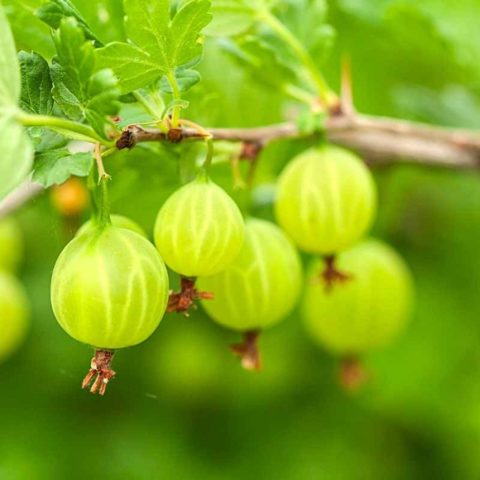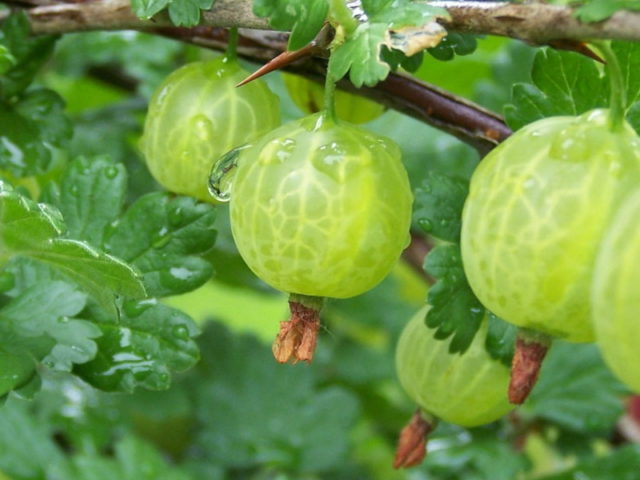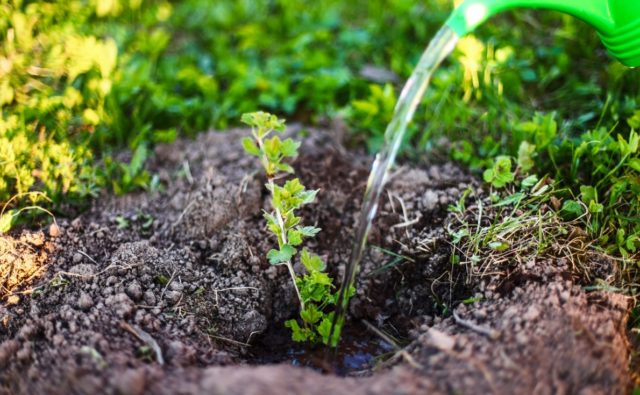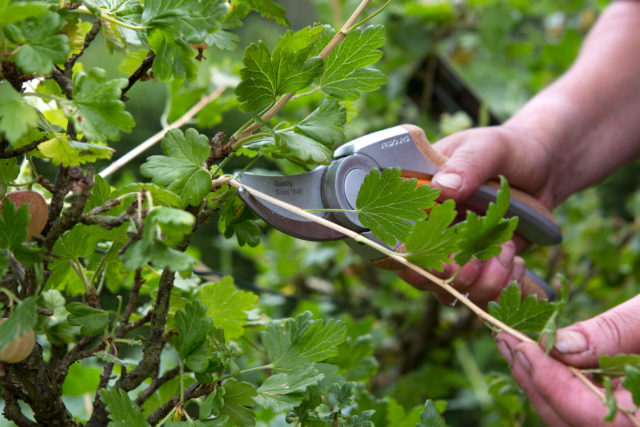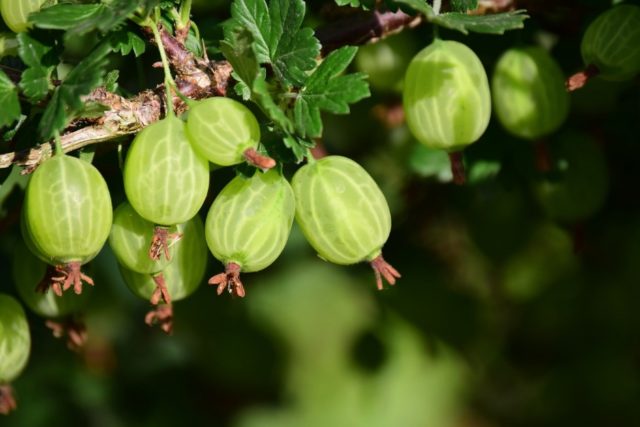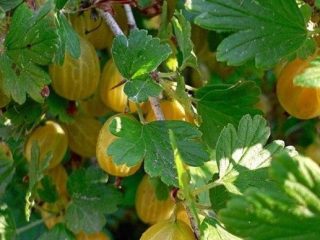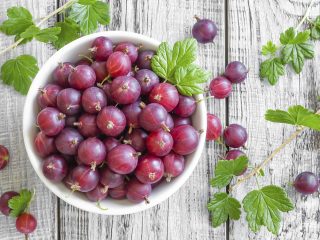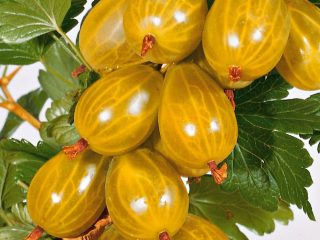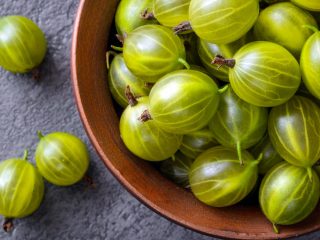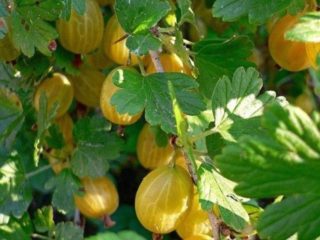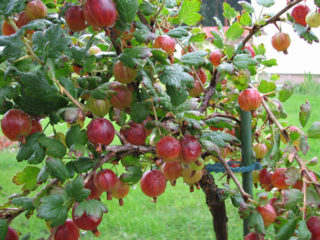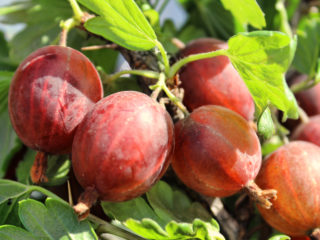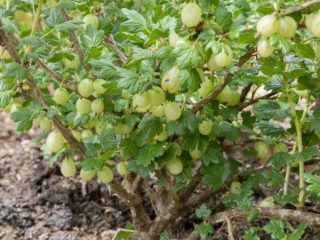Content
Belarusian sugar gooseberry is one of the most popular varieties of this plant species. The plant is undemanding in terms of care and growing conditions, however, in order for fruiting to be abundant and regular, you will still have to follow a number of rules.
Description of the Belarusian sugar gooseberry variety
Belarusian sugar gooseberry is a vigorous plant with self-fertility rates exceeding 65%. The variety is recommended for cultivation in Belarus, Ukraine, the southern regions of Russia, Siberia and the Urals. The shrub does not require pollinators. As the description of the variety, photos and reviews show, the Belarusian gooseberry is difficult to distinguish by appearance from other varieties. The height of the bush is usually about 1 m, but can reach 1.5 m.
The shoots of the bush are relatively thin, but strong and durable, looking upward. When the fruits of the Belarusian sugar gooseberry bush ripen, the branches, densely strewn with berries, bend to the ground under their weight. The thickened central shoots practically do not bend.The culture's shoots have a strong thorniness. The spikes can be single, double or triple. The bush itself is tall, but slightly spreading.
The buds on the shoots begin to bloom with the arrival of spring, and by the end of April the bush is usually completely covered with greenery. The medium-sized folded leaves have five lobes and are a rich green color. The surface of the leaf blade is glossy.
Flowering also begins very early; in central Russia it most often falls in mid-May. The flowers of the Belarusian sugar gooseberry are small, inconspicuous, bisexual and pollinated by insects.
The fruits of the Belarusian gooseberry have a round-oval shape, light green color and are quite large. The weight of one berry can reach 9 g. The skin of the fruit is thin, dense, and hairless. Their flesh is pale green and the juice is clear.
Drought resistance, frost resistance
The Belarusian sugar gooseberry variety is perfectly adapted to an unstable climate with severe frosts in winter. The variety is classified in frost resistance zone 5a, which means that the plant can withstand temperatures down to 28.9 degrees below zero.
This gooseberry variety tolerates heat and drought calmly. After being exposed to unfavorable conditions, plants quickly recover.
Fruiting, productivity
Belarusian sugar gooseberry is considered a mid-early variety. Berries should be expected to ripen at the end of July.
The yield of the variety per bush is 4 - 5 kg. The harvest volumes are increasing every year. The duration of fruiting is 12 - 15 years. After ripening, gooseberry berries of the Belarusian sugar variety are able to remain on the shoots for a long time without falling off or baking in the sun.
The fruits of the Belarusian sugar gooseberry are very tender, sweet, and have a barely pronounced sourness. According to the tasting scale, the variety earned a rating of 4.8 points out of the maximum possible 5. The pulp of the berries contains up to 14% sugars, about 2% acids, as well as a large amount of vitamin C. To make jam from this variety of berries you will need a minimal amount of sugar. The fruits are also suitable for fresh consumption and for making wine.
Advantages and disadvantages
Advantages of the Belarusian sugar gooseberry variety:
- self-fertility;
- regularity of fruiting;
- compactness of the bush;
- large berry size;
- high productivity;
- sweet, dessert fruits;
- resistance to fungal diseases;
- high frost resistance.
Disadvantages of the Belarusian sugar gooseberry variety:
- It is problematic to collect fruits due to the strong thorniness of the shoots.
Features of reproduction
The Belarusian sugar gooseberry variety can be propagated using several methods: cuttings and layering. The most effective method of propagation is layering. This procedure is carried out in the spring; only strong, healthy shoots should be used as layering. It is necessary to dig a hole, place the shoots in it and sprinkle soil on top, leaving only the top above the surface. Next autumn, young plants can be separated from the mother bush.
Propagation by cuttings is not as effective, since their survival rate is lower.
Planting and care
Planting can be done both in spring, in April, and in autumn, in October. Gooseberries of the Belarusian sugar variety should be placed in well-lit places. Insufficient lighting negatively affects the taste of berries and can cause low yields.
Belarusian sugar gooseberries react poorly to stagnant water in the soil. In flooded areas, it is necessary to provide the shrub with good drainage, otherwise its development will be weak. When left in waterlogged soil for a long time, the plant begins to get sick and may even die.
The soil for this gooseberry variety should be light, loamy or sandy loam, neutral or slightly acidic. The optimal acidity level is 6 - 6.5 pH.
When choosing planting material, you should carefully inspect gooseberry seedlings for diseases. It is best to purchase planting material from specialized nurseries and gardening stores. The seedling must have at least one shoot at least 5 mm thick and several skeletal roots at least 15 cm long.
For comfortable development, the plant’s root system needs a large space.During planting, you should maintain a distance of at least 2 m between adjacent rows and 1 m between bushes in rows.
Algorithm for planting Belarusian sugar gooseberries:
- Dig a hole for planting, the size of which is about 50 cm in diameter and about 60 cm in depth.
- Place humus (10 kg), superphosphate (200 g) and potash fertilizers (20 g) into the hole.
- Pour about 3 - 5 liters of water into the hole. Wait until the liquid is completely absorbed and repeat the procedure.
- Place the seedling in the center of the hole, not forgetting to straighten the roots. Cover with soil, deepening the root collar no more than 5 - 7 cm.
- The next day, lightly loosen the soil in the tree trunk circle and mulch. Otherwise, when the soil dries out, the roots may crack.
Growing rules
Proper care of the plant helps to obtain a plentiful and regular harvest for many years.
When the weather is warm and dry outside, watering is usually done once a week. Water the bush directly at the root. During the period of formation of flowers, ovaries and fruits, Belarusian sugar gooseberries need more abundant watering.
Bird droppings, mullein, or ready-made mineral complexes are usually used as fertilizers. If the land on which the gooseberries grow is depleted, fertilizing should be done annually. Fertile soil is fertilized once every three years.
Pruning Belarusian sugar gooseberries is recommended in the spring, before the buds open, or in the autumn, after the harvest has already been harvested. The shoots of the bush are quite flexible, so they can be easily given any desired shape. The plant can be grown in the classic way, with a single-armed or double-armed cordon, as well as on a trellis. To prevent the shoots from bending under the weight of the berries, it is best to tie them up.
As a rule, the plant does not require shelter for the winter. However, if the winter turns out to be little snow, the tree trunk circle should be mulched. Straw, manure and spruce sawdust are perfect for this.
To protect the gooseberry bush from rodents, in the fall you need to dig up the soil between the rows and in the circles near the trunks to destroy their burrows. After this, the trunk and skeletal branches should be tied with spruce branches.
Pests and diseases
The Belarusian sugar gooseberry variety is characterized by high immunity to various diseases. To prevent diseases, the old layer of mulch is removed with the arrival of spring, after first watering the bush with hot water (3 - 5 l). The old layer is replaced with a new one.
An additional preventive measure is to treat the soil under the bush with a 1% solution of Bordeaux mixture. The procedure should be performed before the buds open. Before the formation of buds begins, the bush is treated with Karbofos. This will protect the plant from insects such as aphids, gall midges and sawflies. You can get rid of kidney mites using colloidal sulfur (30 g per 10 liters of water).
Conclusion
Belarusian sugar gooseberry is one of the most popular varieties of green gooseberries among Russian gardeners.It is distinguished by high taste, abundant fruiting, ease of care and high frost resistance.
